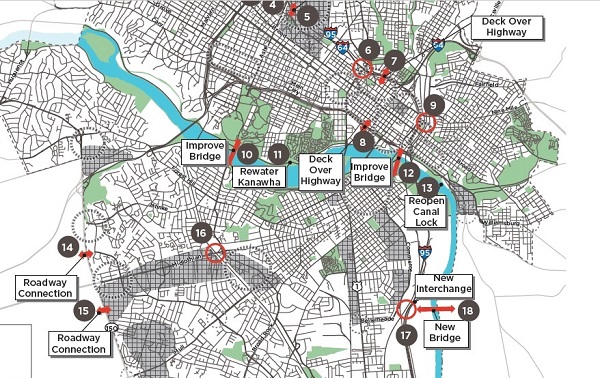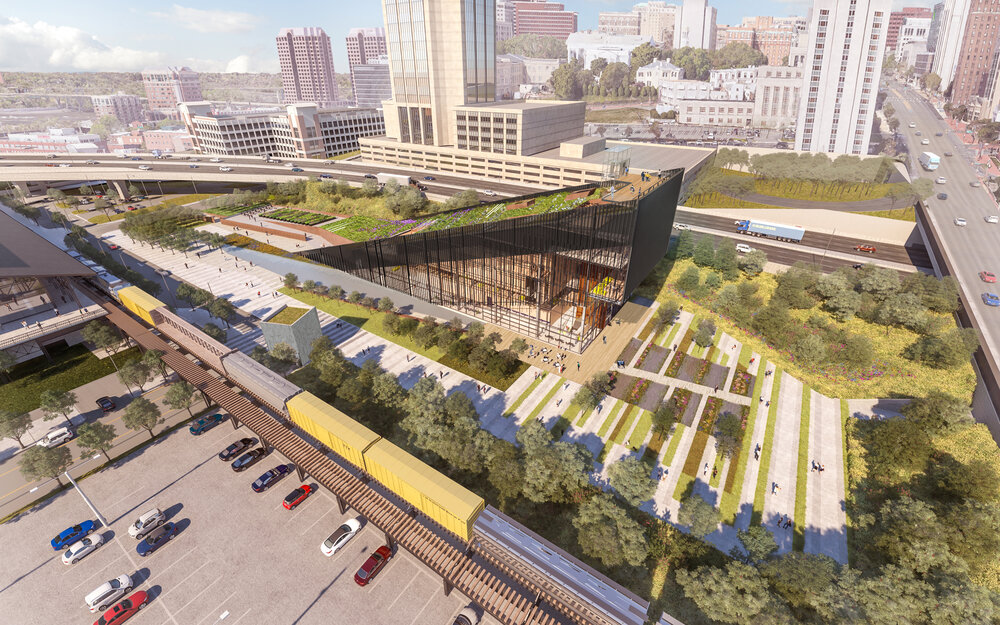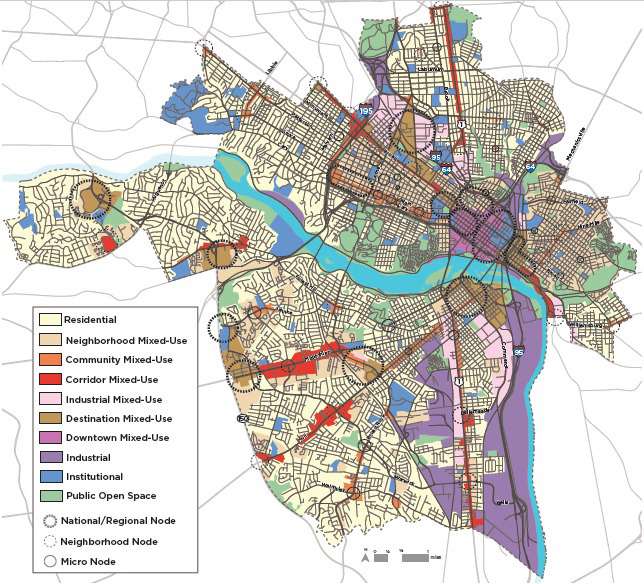Of the 17 goals, 73 objectives and 415 strategies detailed in the nearly 250-page Richmond 300 plan, City Council members see several glaring omissions that they want addressed with forthcoming amendments.
As they said they would do when they adopted the plan last month, councilmembers have submitted what they would like to see changed, removed or added to the years-in-the-making master plan update that’s meant to guide the city’s growth over the next 20 years.
What’s missing, members said — in requests they submitted to Council President Cynthia Newbille — are details on how the city plans to move forward on such things as improving public schools, transforming public housing and providing more housing options for lower-income residents.
Future land use recommendations for certain parts of town such as Oregon Hill and parts of Jackson Ward are taken to task in the requests and asked to be changed. Contradictions or misalignments with separate neighborhood plans that remain in the works also are pointed out, particularly in relation to the Shockoe Bottom area.
The amendments, which BizSense requested from the city, also mention two big-picture projects that stand out among the proposals, with requests to either add or remove them from the plan: the long-discussed slavery memorial and museum in the Bottom, and a potential new bridge envisioned to cross the river at a future interchange of Interstate 95 and Bellemeade Road.

A map of recommended street connections and improvements shows the new bridge and interchange envisioned at I-95 and Bellemeade Road.
Plan shows new bridge at Bellemeade
Two councilmembers — Newbille, and now-former member Kim Gray, whose term has expired — asked that the bridge, which is reflected on some of the plan’s maps, be removed from the document, with Gray calling a river crossing there “problematic.”
“Very surprised to see a new I-95 interchange with Bellemeade Road and bridge across the James River to Henrico County,” Gray said in her requests, contending that the concept received little discussion in presentations.
“The interchange may be OK, but the proposed new bridge in particular is problematic,” Gray wrote. “They raise multiple community, land use, and environmental issues (such as the impact on truck traffic on South Side and adverse impacts on the historic Route 5 corridor).”
Gray and Newbille propose removing all mention of the bridge from the plan, while Newbille, who represents the East End’s Seventh Voter District, also asks that the planned Shockoe slavery memorial and museum, now called the Enslaved African Heritage Campus, be added to and reflected in the plan.
Newbille asks specifically for a narrative about the proposed national museum, which along with the memorial would interpret and commemorate what was the largest slave-trading site on the East Coast. Momentum for the campus has picked up in recent months with city and state funding commitments and moves by the city to attempt to acquire remaining needed parcels.
“It will tell the truth about our history to Americans and to the world,” Newbille wrote in her submission, noting the completion of a preliminary study and a museum design by consulting firm SmithGroup, which designed the National Museum of African American History and Culture in Washington, D.C.

A rendering of the slavery museum planned between the train tracks and the interstate. (Courtesy of SmithGroup)
“We intend to overcome our history of racism and race-based slavery,” the submission states. “Monument Avenue is gone. This museum, on the major north-south highway of America’s East Coast, will proclaim that Richmond is no longer the Capital of the Confederacy, but a Capital of Truth and Reconciliation.”
Building heights a concern for Shockoe, Oregon Hill
Newbille also calls for the plan to cite the in-the-works Shockoe Small Area Plan, and defer to it in regard to allowable building heights. Complaints of apparent contradictions between the plans were brought up in the final months of Richmond 300’s development, and Newbille and Gray also call for restrictions protecting the river view from Libby Hill Park.
Also relating to building heights, Stephanie Lynch of the Fifth District asked that the “neighborhood mixed-use” designation for Oregon Hill restrict buildings to two stories to better reflect current conditions. The designation in the plan envisions building heights of up to four stories, and taller in some places, but residents there have said such heights would be inappropriate.
Regarding schools, former councilmember Chris Hilbert said more information needs to be added to the plan. While it doesn’t go into details, the plan does mention schools among recommended action steps for one of the plan’s “Big Moves” focusing on city facilities.
Specifically, it recommends developing a schools facility master plan based on the Richmond 300 future land use plan, to determine where schools may need to be established, relocated or closed. It also recommends exploring whether to add a new school in the downtown area.
More housing options sought
Newbille, Gray and Ellen Robertson of the Sixth District also asked for more emphasis and detail in the plan on how to achieve its stated goal of increasing the city’s lower-income housing stock.
The plan encourages development of more housing options in Richmond and the creation of 10,000 new housing units for low-income households in the next 10 years, but Robertson contends that such goals couldn’t be achieved based on the land uses recommended in the plan.
In remarks she gave before the council vote in December, Robertson said the plan should accommodate more inclusive housing, stating that 33 percent of available land in the city is zoned for single-family houses and about 15 percent is zoned for multifamily residential development. She also said the plan’s “priority growth nodes” are disproportionate across the city.
“When you look at the map and where the priority nodes are, the disparity in setting priorities for the city of Richmond continues to be exhibited in the priority maps that we have before us,” Robertson said in the meeting.
“I had previously even considered not supporting the plan,” she said, adding that she shared her concerns in writing with city administrators and staff. “I have been given the assurance and I believe that the council is prepared to act expediently to address an amendment to this plan.”
Robertson’s reservations about the plan were among reasons why councilmembers said they would revisit it post-adoption. Newbille asked at that meeting that members submit amendments by Jan. 8 so they could be considered at a meeting this month.
The council has not acted on the amendments yet. Steven Skinner, a spokesman for the council chief of staff’s office, said the requests are anticipated to be introduced at an upcoming meeting.
The amendments come as Mark Olinger, the city planning director who helped lead Richmond 300’s development, resigned abruptly last week after a decade with the city.
Of the 17 goals, 73 objectives and 415 strategies detailed in the nearly 250-page Richmond 300 plan, City Council members see several glaring omissions that they want addressed with forthcoming amendments.
As they said they would do when they adopted the plan last month, councilmembers have submitted what they would like to see changed, removed or added to the years-in-the-making master plan update that’s meant to guide the city’s growth over the next 20 years.
What’s missing, members said — in requests they submitted to Council President Cynthia Newbille — are details on how the city plans to move forward on such things as improving public schools, transforming public housing and providing more housing options for lower-income residents.
Future land use recommendations for certain parts of town such as Oregon Hill and parts of Jackson Ward are taken to task in the requests and asked to be changed. Contradictions or misalignments with separate neighborhood plans that remain in the works also are pointed out, particularly in relation to the Shockoe Bottom area.
The amendments, which BizSense requested from the city, also mention two big-picture projects that stand out among the proposals, with requests to either add or remove them from the plan: the long-discussed slavery memorial and museum in the Bottom, and a potential new bridge envisioned to cross the river at a future interchange of Interstate 95 and Bellemeade Road.

A map of recommended street connections and improvements shows the new bridge and interchange envisioned at I-95 and Bellemeade Road.
Plan shows new bridge at Bellemeade
Two councilmembers — Newbille, and now-former member Kim Gray, whose term has expired — asked that the bridge, which is reflected on some of the plan’s maps, be removed from the document, with Gray calling a river crossing there “problematic.”
“Very surprised to see a new I-95 interchange with Bellemeade Road and bridge across the James River to Henrico County,” Gray said in her requests, contending that the concept received little discussion in presentations.
“The interchange may be OK, but the proposed new bridge in particular is problematic,” Gray wrote. “They raise multiple community, land use, and environmental issues (such as the impact on truck traffic on South Side and adverse impacts on the historic Route 5 corridor).”
Gray and Newbille propose removing all mention of the bridge from the plan, while Newbille, who represents the East End’s Seventh Voter District, also asks that the planned Shockoe slavery memorial and museum, now called the Enslaved African Heritage Campus, be added to and reflected in the plan.
Newbille asks specifically for a narrative about the proposed national museum, which along with the memorial would interpret and commemorate what was the largest slave-trading site on the East Coast. Momentum for the campus has picked up in recent months with city and state funding commitments and moves by the city to attempt to acquire remaining needed parcels.
“It will tell the truth about our history to Americans and to the world,” Newbille wrote in her submission, noting the completion of a preliminary study and a museum design by consulting firm SmithGroup, which designed the National Museum of African American History and Culture in Washington, D.C.

A rendering of the slavery museum planned between the train tracks and the interstate. (Courtesy of SmithGroup)
“We intend to overcome our history of racism and race-based slavery,” the submission states. “Monument Avenue is gone. This museum, on the major north-south highway of America’s East Coast, will proclaim that Richmond is no longer the Capital of the Confederacy, but a Capital of Truth and Reconciliation.”
Building heights a concern for Shockoe, Oregon Hill
Newbille also calls for the plan to cite the in-the-works Shockoe Small Area Plan, and defer to it in regard to allowable building heights. Complaints of apparent contradictions between the plans were brought up in the final months of Richmond 300’s development, and Newbille and Gray also call for restrictions protecting the river view from Libby Hill Park.
Also relating to building heights, Stephanie Lynch of the Fifth District asked that the “neighborhood mixed-use” designation for Oregon Hill restrict buildings to two stories to better reflect current conditions. The designation in the plan envisions building heights of up to four stories, and taller in some places, but residents there have said such heights would be inappropriate.
Regarding schools, former councilmember Chris Hilbert said more information needs to be added to the plan. While it doesn’t go into details, the plan does mention schools among recommended action steps for one of the plan’s “Big Moves” focusing on city facilities.
Specifically, it recommends developing a schools facility master plan based on the Richmond 300 future land use plan, to determine where schools may need to be established, relocated or closed. It also recommends exploring whether to add a new school in the downtown area.
More housing options sought
Newbille, Gray and Ellen Robertson of the Sixth District also asked for more emphasis and detail in the plan on how to achieve its stated goal of increasing the city’s lower-income housing stock.
The plan encourages development of more housing options in Richmond and the creation of 10,000 new housing units for low-income households in the next 10 years, but Robertson contends that such goals couldn’t be achieved based on the land uses recommended in the plan.
In remarks she gave before the council vote in December, Robertson said the plan should accommodate more inclusive housing, stating that 33 percent of available land in the city is zoned for single-family houses and about 15 percent is zoned for multifamily residential development. She also said the plan’s “priority growth nodes” are disproportionate across the city.
“When you look at the map and where the priority nodes are, the disparity in setting priorities for the city of Richmond continues to be exhibited in the priority maps that we have before us,” Robertson said in the meeting.
“I had previously even considered not supporting the plan,” she said, adding that she shared her concerns in writing with city administrators and staff. “I have been given the assurance and I believe that the council is prepared to act expediently to address an amendment to this plan.”
Robertson’s reservations about the plan were among reasons why councilmembers said they would revisit it post-adoption. Newbille asked at that meeting that members submit amendments by Jan. 8 so they could be considered at a meeting this month.
The council has not acted on the amendments yet. Steven Skinner, a spokesman for the council chief of staff’s office, said the requests are anticipated to be introduced at an upcoming meeting.
The amendments come as Mark Olinger, the city planning director who helped lead Richmond 300’s development, resigned abruptly last week after a decade with the city.

Typical mess from the city lol